Oil Gas Business Cards: 5 Power Moves to Dominate the Market
In the competitive universe of oil and gas, first impressions are everything. Whether an experienced energy executive or a new startup supplier, your oil gas business card is not a simple piece of paper—it’s a brand-building device, a icebreaker, and a trust generator. In an industry with cutthroat competition and advancing technologies, carrying a business card that exudes innovation, dependability, and professionalism can make all the difference in clinching those all-important deals.
Here, we’ll deconstruct 5 power moves that will make your business cards go from forgettable to unforgettable. These suggestions are specifically for oilfield services, refineries, fuel logistics, petroleum consulting, and renewable transition professionals—any industry where strategic networking intersects with industry expertise.
Table of Contents
5 Power Moves to Dominate the Market- Oil Gas Business Cards
1. Utilize Industry-Specific Design Elements-Oil Gas Business Cards:
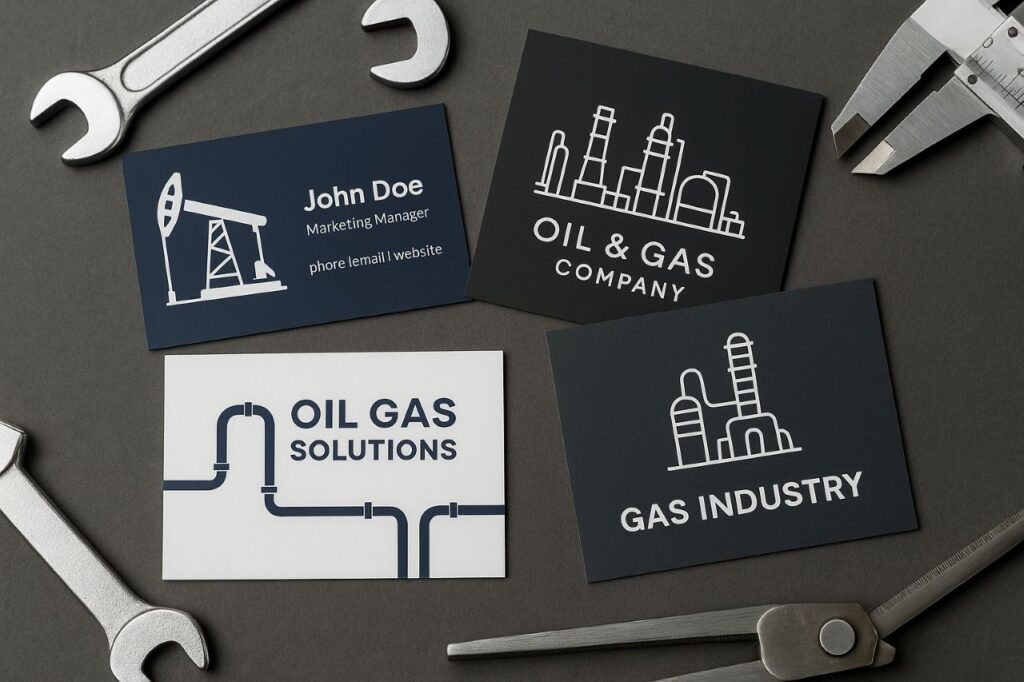
Incorporate Industry-Relevant Visuals:
For oil gas business cards, generic templates are not going to work. This is an industry based on precision, engineering, and trust—your business card should look as professional. One of the best ways to take your card to the next level is to utilize design elements that visually tie your card into the energy industry.
- Add Industry-Specific Images: Integrate subtle yet effective visuals that will appeal to oil and gas professionals:
- Oil Rigs & Derricks: Suitable for upstream professionals like geologists, drillers, or exploration consultants. A silhouette of a jack-up rig or land-based pump-jack will instantly convey your niche.
- Pipeline Icons: Suitable for midstream companies, particularly pipeline logistics and inspection service firms.
- Refinery Graphics: Refinery towers or pressure vessels are great options for downstream refiners, petrochemical distributors, or fuel marketers.
- Gas Nozzles & Tanker Trucks: Ideal for companies operating in fuel delivery, bulk transportation, or retail fuel stations.
Keep the graphics vector-based and simple. You don’t want to imply industry—overwhelm the design instead.
For what works in vector icons, take a look at Flaticon’s Oil & Gas Icons.
Use Textures that Evoke Industry Materials:
The oil and gas industry is hard to touch and rough—to allow your card to have that tactile sense, use creative textures and finishes:
- Brushed Metal Finish: Exhibits industrial toughness, best for pipeline inspectors or engineering companies.
- Matte Black or Charcoal: Emphasizes seriousness and sophistication, excellent for C-level executives or consultants.
- Embossed Oil Stain Graphics: Gives depth and thematic connection to oil gas business cards, especially for field services or mechanical operations.
High-quality textures can be seen in advance with specialty printers such as Moo Business Cards, which provide luxe finishes and embossing.
Avoid Overused Cliches:
Whereas fire, oil drips, or gas pump signs may seem fitting, they end up appearing old and busy. Instead:
- Employ crisp, vector icons that suggest oil drilling, fuel transportation, or refining.
- Employ design simplicity that conveys strength through accuracy—much like the industry itself.
- Refer to custom drawings or abstract overlays from your real fieldwork or project photographs.
Pro Tip: Consistency in design matters. If your website, pitch deck, and uniforms feature navy blue and gold with refinery silhouettes—take that same theme to your oil gas business cards. Consistent brand identity helps reinforce professionalism and trust.
By incorporating imagery and textures that are directly related to your industry, oil gas business cards transcend contact info—they become an emblem of authenticity and industry relevance. And in a space where deals can start with a handshake and a card, design is actually strategy.
2. Emphasize Your Unique Value Proposition (UVP) – Oil Gas Business Cards

Show What Makes You Different:
In an industry as crowded as oil and gas, oil gas business cards need to do more than include your title and contact details. The most powerful way to differentiate is by explicitly declaring your unique value proposition (UVP)—a brief, compelling statement that tells your prospect what sets your service or expertise apart.
Rather than just writing “Operations Manager – XYZ Drilling Co.,” do something more specific and value-driven, such as:
- “Cutting Downtime with Proactive Pipeline Maintenance”
- “Quickest Onshore Drilling Permits in the Gulf Territory”
- “Bulk Diesel Distribution When & Where You Need It”
These UVPs inform recipients why to contact—and what’s in it for them.
For tips on writing UVPs, check out HubSpot’s UVP advice.
Where to Place Your UVP:
- Ideally, place your UVP immediately below your name or occupation.
- Choose a slightly larger font size or boldness to make it stand out—without overwhelming your company logo.
- On double-sided oil gas business cards, the UVP can also be placed on the back, alongside a list of services or a QR code.
Tip: Make it one sentence only. No jargon. Your card is a hook, not an entire brochure.
Design Tips to Emphasize Your UVP:
- Employ metallic foil stamping (silver or gold) to make the UVP stand out visually and distinguish it.
- Contrast colors such as dark navy background and white or gold UVP lettering to render it readable in low-light conditions (e.g., refineries or work sites).
- Print your UVP on top of a textured band or icon bar pertinent to your oil and gas industry (e.g., refinery graphics for downstream sales or drilling icons for upstream).
Examples of foil-stamped business cards can be found on Jukebox Print’s metallic design gallery.
Why It Matters for Oil & Gas Professionals:
The average business card gets a glance of just 5–10 seconds before it’s either pocketed, scanned, or forgotten. A clear UVP ensures yours becomes memorable and positioned as a solution, not just a contact.
Whether you’re a project engineer, logistics coordinator, or petroleum consultant, your oil gas business cards should convey your niche and benefit within seconds.
A 2022 report by Oil & Gas IQ points out the way individualization in vendor content—such as business cards—is able to boost lead follow-ups by 32%.
Pro Tip: Make your UVP your LinkedIn headline, email signature, and website opening as well. Consistency of touchpoints strengthens your brand identity and makes you a thought leader in your oil and gas space.
3. Spend on High-Quality Materials-Oil Gas Business Cards:

Texture Builds Trust:
In the world of oil and gas—where deals are worth millions—everything matters. That means even the texture, weight, and longevity of your oil gas business card. Spending on high-quality materials doesn’t only make your card distinctive—it sends a message of reliability, attention to detail, and expertise
If your business card is too thin or generic, it can unconsciously convey the same about your service. Conversely, a heavy, high-end card with a strong finish can make a strong impression.
Recommended Materials for Oil Gas Business Cards:
Following are some high-end materials and finishes specific to the industry:
- Silk Laminated (16pt or 18pt): Provides a smooth, professional finish that’s smudge-proof and long-lasting. Suitable for executives and office professionals.
- Triple-Layered Cards: With a colored edge or core (such as red, black, or metallic silver), the cards are dynamic and project power—ideal for energy consulting or project management professionals.
- Textured Cotton or Linen: Provides tactile feel, commonly used in bespoke services or oilfield consulting professionals.
- Plastic Cards (Frosted/Clear): Perfect for harsh conditions. Waterproof and sturdy, perfect for field engineers and logistics teams.
- Metal Business Cards: Stainless steel, brushed aluminum, or copper cards are luxury options for C-suite executives, refinery owners, or VIP customers.
See a variety of high-end materials on Luxury Business Cards by Moo and Metal Business Cards.
Finish Options that Elevate Your Brand:
Finishing options that go well with oil gas business cards are:
- Spot UV Coating: Applies gloss to selected design features such as your logo or UVP, highlighting key areas.
- Embossing/Debossing: Inserts a tactile texture to your business name or emblem.
- Matte + Foil Combo: A matte card with gold, silver, or copper foil creates a sophisticated appearance that fits the industry’s bold brand identity.
For inspiration on mixing textures and finishes, view Jukebox Print’s inspiration gallery.
Why Premium Materials Matter in the Oil & Gas Industry:
Where branding by sight and touch is so important in forming partnerships and vendor rapport, spending money on quality oil gas business cards makes you stand out from the crowd. From walking the floor at an industry convention to being out on location at a refinery or networking at a conference offshore, a tough and elegant card meets your audience’s expectations.
Example: A bulk fuel supplier employing matte cards that are oil stain embossed immediately supports their brand and gains trust among fleet managers and industrial customers.
Pro Tip: If you’re frequently exposed to outdoor or industrial settings, use rugged finishes such as waterproof plastic or coated paper. Always store your cards in a protective case to maintain sharp corners and professional look.
4. Add a Scannable QR Code – Oil Gas Business Cards:
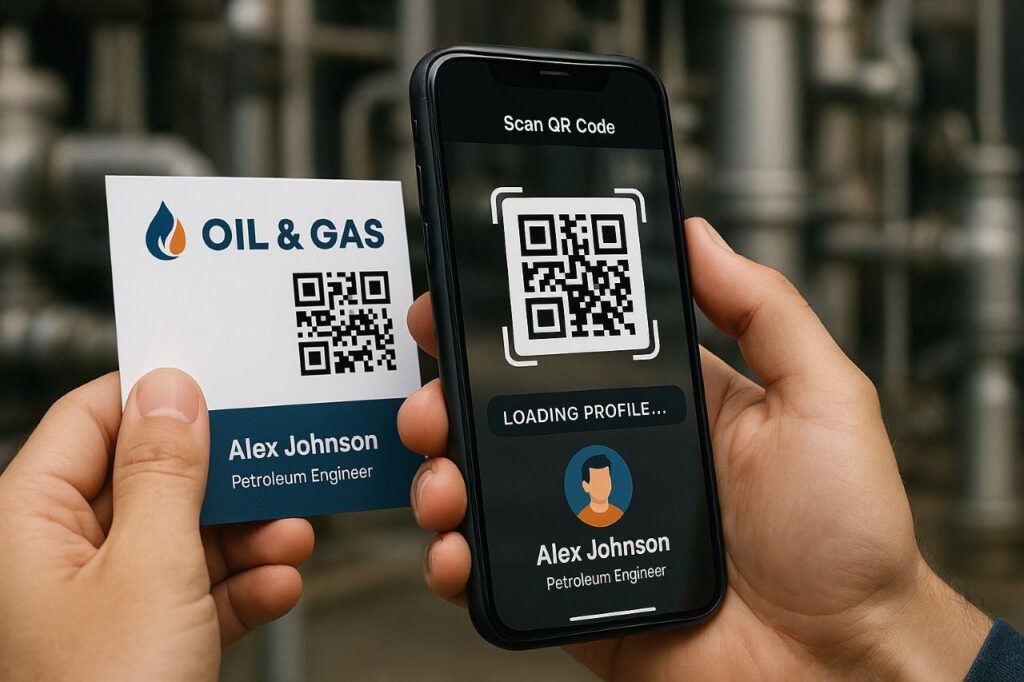
Bridge the Gap Between Print and Digital:
With the energy sector embracing digital solutions at breakneck speeds—from cloud-based logistics to smart drilling technology—it’s high time your oil gas business cards followed suit. One of the most successful methods for transforming your card is to incorporate a scannable QR code that bridges the gap between offline interaction and online presence.
QR codes turn your card into an interactive one. In a single scan, your contact can:
- Look at your LinkedIn profile.
- Download your business brochure.
- Book an appointment.
- Get access to your product catalog.
- Look at current fuel price information or refinery capacity.
Example: A logistics manager distributes oil gas business cards at a petroleum show with a QR code taking them directly to an appointment portal for bulk diesel bookings. It simplifies follow-through and demonstrates tech-savvy.
Find out more about networking applications for QR codes at QR Code Generator.
Smart Placement for QR Codes:
In order to place a QR code wisely within your design:
- Position it on the back side of the card for a neater front design.
- Align it with your brand color scheme for visual branding.
- Include a brief call-to-action close by such as:
- “Scan to Get a Quote”
- “View Case Studies”
- “Fuel Delivery in 24 Hours – Start Here”
Don’t put it too close to the card edges, as some scanners will not read edge-aligned codes.
Find best practices for placement at Scanova’s QR Design Tips.
Use Dynamic QR Codes for Flexibility:
Static QR codes are locked to a single link—but dynamic QR codes can be changed at any time without having to reprint your cards. This comes in handy for:
- Linking to season-specific promotions.
- Changing contact info or fleet services.
- A/B testing landing pages per trade shows.
Example: A fuel services company at various expos employs the same oil gas business cards, but changes their QR code target according to event location—Houston, Dubai, or Calgary.
Design dynamic QR codes with tracking through tools like Beaconstac or QR Code Generator PRO.
Security and Professionalism:
Always test your QR code on different devices (Android/iOS) and make sure it goes to mobile-friendly pages. A dead or slow-loading link harms trust—something particularly vital in the oil and gas industry where accuracy and dependability are not optional.
Tip: Include a branded short URL in your QR code to ensure brand consistency and professionalism (e.g., fuelhub.io/profile/johndoe).
Pro Tip: Future-proof your oil gas business cards by combining QR codes with NFC chips or AR-enhanced cards. These are still new technologies in B2B environments—but being an early adopter demonstrates leadership and creativity.
Find out how NFC business cards can take your brand to the next level in tech-leading sectors.
5. Add Certifications and Safety Credentials-Oil Gas Business Cards:

Build Instant Trust with Industry Credentials:
In the oil and gas industry, where compliance, safety, and technical accuracy are not negotiable, showing certifications and associations on your oil gas business cards is a very effective method of creating credibility in the initial handshake.
Whether it’s meeting a refinery manager, pipeline inspector, or fuel fleet coordinator, industry-specific certifications have the power to convey trustworthiness, professionalism, and compliance to safety standards—all without you uttering a single word.
Which Certifications to Display:
These are some high-impact certifications that can be subtly added to your oil gas business cards, particularly if you work in operational, environmental, or compliance positions:
- ISO 45001 (Occupational Health & Safety): Indicates a commitment to safe operations throughout oilfields and facilities. → More on ISO 45001
- API Membership (American Petroleum Institute): Demonstrates alignment with industry standards in equipment and operation standards. → API Standards & Membership Info
- OSHA Compliance (U.S. Only): Demands safety training and operational hazard awareness. Highly applicable for field engineers, drillers, and inspection contractors. → Visit OSHA.gov
- TWIC Certification (Transportation Worker Identification Credential): Mandatory for professionals entering U.S. ports or refineries.
- HAZWOPER Training: For experts working with hazardous waste and materials during refinery or pipeline operations.
Example: A pipeline safety coordinator incorporates tiny OSHA and API logos in the lower-right quadrant of his oil gas business cards, establishing his credentials prior to discussion ever taking place.
Where to Place Certifications on Your Card:
Make it clear, simple, and deliberate:
- Utilize small logo symbols in grayscale or single-color presentation to minimize clutter.
- Optimal placement: bottom right or left corners, side by side your QR code, or on the back panel close to your value proposition or list of services.
- Ensure every badge/logo is readable and does not overwhelm your name or title.
Tip: Keep the number of logos in check. Use a maximum of 2–3, with focus on those most applicable to your occupation or client issues.
Certifications Matter in B2B Oil & Gas:
Displaying credentials on oil gas business cards isn’t just about style—it directly impacts how you’re perceived in business-critical environments where compliance, insurance, and procurement teams look for proof of credibility.
A 2023 study from Rigzone found that vendors and field operators displaying industry-aligned credentials on marketing materials received 26% more callbacks compared to those who didn’t.
Learn how to leverage certifications in your branding from BIC Magazine.
Pro Tip: If you’re a consultant or vendor operating across several markets, think about region-specific badges—i.e., CE marking for EU-based tools or NEBOSH for global safety training.
Also, double-check that the certifications you display are current and can be verified. Never put outdated or expired credentials on your oil gas business cards, as that destroys trust rather than creating it.
Conclusion: Your Business Card is Your Industry Signature
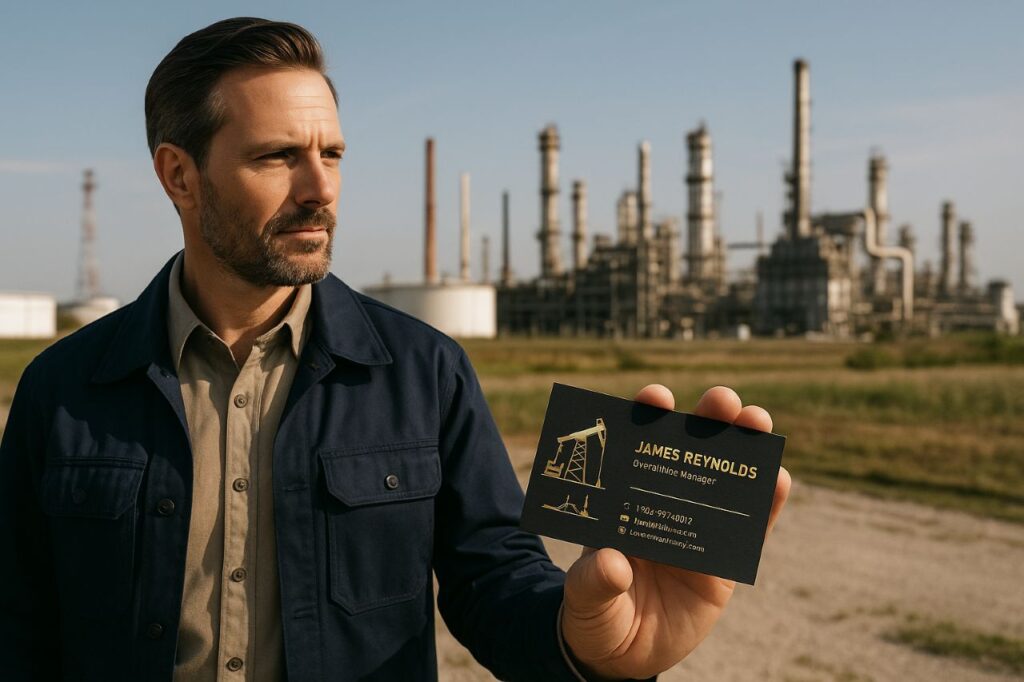
Even though digital networking tools and virtual business platforms have grown quickly over the past few years, oil gas business cards are still one of the most compelling, physical branding instruments in the energy industry. Indeed, the risk, complexity, and high-value character of oil and gas operations render face-to-face trust even more important. And much of that trust begins with a handshake—and a card.
From fuel distribution managers to pipeline engineers and oilfield contractors, the business card is an extension of your personal brand. It’s more than your phone number—it’s more about demonstrating credibility, safety compliance, service capability, and professionalism in one small space. Strategically designed and utilized, your card is a silent pitch, a leave-behind sales piece, and a conversation starter rolled into one.
In this article, we detailed 10 power moves to turn your oil gas business cards from bland to powerful. These range from utilizing industry-specific imagery such as oil rigs or refinery silhouettes, choosing tough, high-quality materials that will survive rough environments, and using both sides of the card for maximum information saturation without cluttering.
Including dynamic QR codes, displaying certifications such as API or OSHA certification, and highlighting your value proposition all serve to support your standing as a respected, qualified partner. Small details—such as NFC chip use, personalized textures, or matte finishes—can further set you apart in a field where differentiation may be the difference you require to secure contracts or acquire long-term customers.
Keep in mind, oil and gas is a high-risk, high-trust business. Whether you are bidding on a maintenance contract, speaking at an expo, or building contacts at a refinery facility, a quality business card indicates you value presentation, clarity, and professionalism—values that are also reflected in your work.
Don’t settle for standard templates or flimsy cards. Design with purpose. Print with pride. Carry with confidence. When it comes to securing high-stakes opportunities, your oil gas business cards could very well be the first (and most lasting) impression you leave behind.
Collaborate with a designer or try custom card sites such as Moo, Vistaprint, or Jukebox Print to create business cards that reflect your energy brand’s quality and aspirations.
Also Read: Gas Card EDF: 5 Powerful Reasons Every Driver Should Know
Frequently Asked Questions (FAQs)
Why are specialized oil gas business cards important?
They communicate your role, credibility, and industry alignment in a glance—especially in high-stakes energy environments where precision and safety matter.
What materials are best for oil gas business cards in rugged environments?
Plastic, metal, or silk-laminated cards are ideal for durability. They resist oil, water, and outdoor exposure better than standard cards.
Should I include a QR code on my oil gas business cards?
Yes. A QR code connects print to digital, allowing instant access to portfolios, pricing, maps, or service requests. Use a dynamic QR for easy updating.
Is it appropriate to use double-sided printing?
Absolutely. Use one side for contact info and the other for services, service area, or a call to action. It maximizes space and professionalism.
Can I include safety certifications like OSHA or API?
Yes. Including 1–3 relevant certifications builds trust, especially in B2B transactions. Keep logos small and neatly placed.
Should I personalize my card with a photo?
Only if you attend lots of expos or network heavily. A professional head-shot helps people remember you. Avoid casual or low-res photos.
What should I avoid including on oil gas business cards?
Avoid outdated info (like fax), overly cluttered layouts, unbranded emails (e.g., Gmail), or irrelevant social media handles.
How often should I update my business cards?
Review them annually or after major changes (new title, contact info, services, or branding updates).
Can I use vertical card layouts in the oil and gas industry?
Yes, but make sure they’re legible and align with your company’s branding. Horizontal remains more traditional and widely accepted.
What’s the best place to print custom oil gas business cards?
Trusted vendors include Vistaprint, Moo, Jukebox, and Metal Business Cards for high-end options.



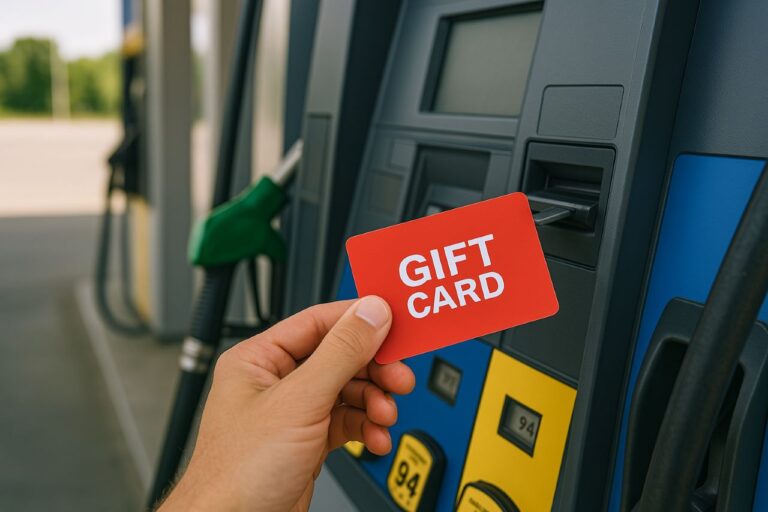
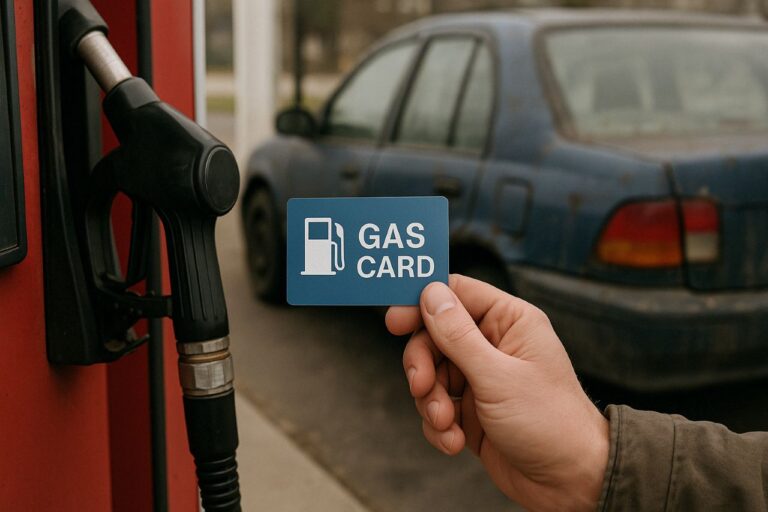

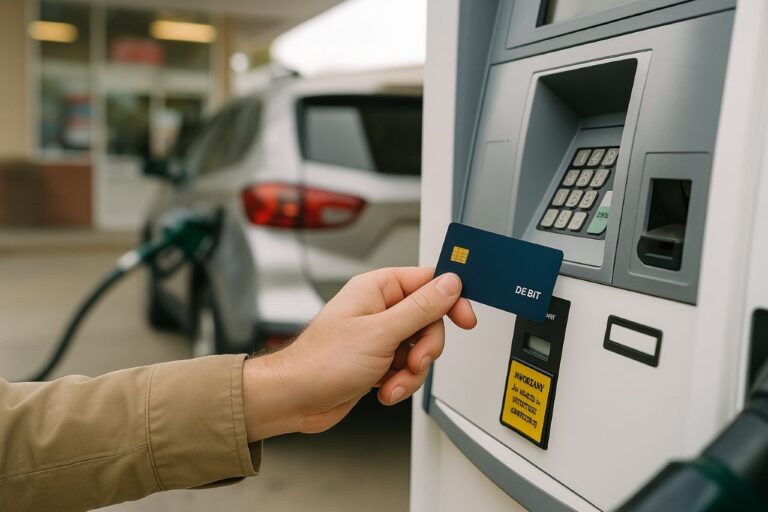

One Comment